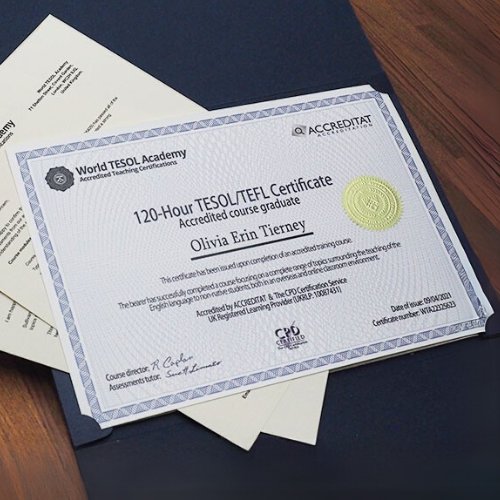
💼 ESL Job Guide 💼
Embarking on a career as an ESL teacher is an exciting and rewarding journey. With your accredited teaching certificate at hand, a world of possibilities now awaits you!
Whether you’re just starting out or looking to land your next teaching job, knowing how to navigate the job search process is key. From understanding the essential qualifications requirements to finding teaching opportunities and preparing for interviews, being well-prepared can make all the difference.
This comprehensive guide will walk you through the key steps of the ESL job search process. We’ll take a look at which qualifications and application documents to prepare, how to find job opportunities, and how to approach your job interviews with confidence.
Let’s dive into the details to ensure you’re well-prepared for finding your next teaching job!
Prepare your qualifications
To secure a job as a professional English teacher, ESL employers and governments around the world typically expect candidates to meet specific qualification requirements. Understanding these requirements clearly, and preparing for them early, can help make you a more competitive candidate and make the job search process smoother.
Let’s start by first taking a look at the core qualifications and documents you should consider preparing!
📃 Teaching certificates
The cornerstone of your ESL teaching qualifications is your accredited 120-hour TESOL/TEFL certificate. Earning this professional teaching certificate ensures that you are equipped with the essential skills needed to plan lessons effectively, manage classrooms confidently, and deliver engaging lessons that meet the expectations of ESL employers.
A 120-hour TESOL/TEFL certificate is also widely considered the industry-standard minimum requirement for ESL teachers worldwide. Securing this essential certificate is therefore the first critical step toward a building a successful ESL teaching career.
Teachers who wish to advance their careers often choose to pursue additional certifications, such as specialist skills certificates.
These types of certificates are designed to further develop your teaching skills and qualifications towards more specialized areas of ESL teaching. Some of the most popular options are certification courses that focus on specific types of learners, such as young learners, adult learners, and online learners.
Earning these types of specialist certificates is an effective way to strengthen your qualifications, which in turn can help boost your employability and earning potential, especially if you enjoy teaching specific types of students.
🧑🏫 Specialist training: Feel free to browse our accredited specialist skills courses, which are designed to further expand on your TESOL/TEFL training:
- 💻 80-hour TEOL course (Teaching English to Online Learners)
- 👨 70-hour TEAL course (Teaching English to Adult Learners)
- 🧒 60-hour TEYL course (Teaching English to Young Learners)
🎓 University degrees
In addition to your teaching certificate, some countries and employers may also require that you possess a university degree—often due to government visa regulations. While a degree isn’t mandatory everywhere, having a degree can help open up doors and provide access to more job opportunities, especially if your degree is related to education, languages, or English teaching.
However, if you don’t have a degree, don’t worry—it’s still possible to start teaching overseas and online as long as you focus on obtaining other valuable qualifications, such as specialist teaching certifications and practical experience.
🧑🏫 Teaching experience
Teaching experience is a commonly listed as a requirement in ESL job ads, especially for more advanced teaching positions. Having documented teaching experience can help demonstrate to employers that you have a practical understanding of how to plan and deliver effective ESL lessons, and that you are able to quickly settle into your new role without the need for extensive internal training.
While experience is often highly valued by many employers, it is not always required, especially for entry-level positions. If you are just starting out and lack formal teaching experience, it can be helpful to review your previous roles and look for transferable skills. Many aspiring teachers often have relevant experience without realizing it, such as training coworkers, mentoring, or working with children in other settings.
📜English proficiency certificates
For non-native ESL teachers, obtaining an English proficiency certificate is highly recommended, as it can help showcase that you possess a strong enough command of the English language to confidently teach it. The most commonly accepted types of English proficiency certificates are the TOEFL (Test of English as a Foreign Language) and IELTS (International English Language Testing System).
💡Important to note: While the qualifications mentioned above provide a solid foundation for building your career, the ESL teaching landscape is diverse, and individual employers may have their own specific expectations and requirements.
Being adaptable and well-prepared can help you to effectively navigate these different demands and make the job search process smoother.
✅ Certificate authentication
If you plan to teach abroad, you may be required to authenticate your 120-hour TESOL/TEFL certificate and other documents as part of the visa or work permit process.
This often involves getting your certificate apostilled or embassy attested, depending on the requirements of the country where you’ll be teaching:
- Apostille is a document legalization method used between countries that are part of the Hague Apostille Convention. It confirms that your document is genuine and accepted for legal use in the member countries.
- Embassy attestation is commonly used in countries that do not accept apostilles. This process tends to be more detailed, often including multiple steps through your home government and the destination country’s embassy.
Be sure to check with your employer or the relevant immigration authority/embassy to understand which process you’ll need to follow. It’s a good idea to begin this step early to avoid delays in your job placement or visa application.
💡Preparation tip: If you’d like to learn more about how to get your teaching certificate authenticated for use overseas, feel free to follow our authentication guides:
- Apostille guide: Step-by-step guide on how to get your certificate apostilled for use in China and other apostille member countries.
- Vietnam — Embassy attestation guide: Step-by-step guide on how to get your certificate embassy attested for use in Vietnam.
Prepare your application documents
After preparing your qualifications, the next step is to update your job application documents. This is a crucial part of the job search process, and it requires careful attention before you begin applying for teaching positions. A well-prepared application can significantly increase your chances of landing the job.
📝 Update your ESL resume
A good first step is to update your resume so that it’s tailored for ESL teaching. Your resume is your professional profile, providing potential employers with a clear overview of your relevant skills, qualifications, and experience that align with the diverse demands of ESL education.
While it’s acceptable to create a general resume for ESL teaching, it’s highly recommended that you research the employer and carefully review the job posting for clues about what they are looking for in successful candidates. You are then able to tailor your resume to the specific position by highlighting the most relevant skills, traits, and experience.
💡Top tip: Want to learn how to tailor your resume for ESL teaching?
To help you get started with tailoring your resume for ESL teaching, feel free to use our Ultimate ESL Resume Guide.
This handy guide provides practical tips, templates, and guidelines on how to create a professional ESL resume that can help boost your chances of landing your next teaching job.
📄 Draft a cover letter
Many teachers unfortunately skip this step, thinking that a resume is enough. While a resume gives employers an overview of your experience, skills, and qualifications, a cover letter allows you to make your job application more personal by expanding on your motivation and enthusiasm for the teaching position.
When preparing your cover letter, make sure to tailor it to the specific position you are applying for, as this can help you to clearly highlight why you’re a strong fit for the role. It’s also a great way to show the employer that you’ve taken the time to understand their needs and what the position entails.
By preparing a well-crafted cover letter, you’ll be able to set yourself apart from other applicants and increase your chances of being invited for an interview.
💡Top tip: To help you get started with crafting your cover letter, feel free to explore our ESL cover letter guide for inspiration on how to prepare this important supporting document.
🤝 Gather your references
In addition to preparing your essential application documents, it’s also good to prepare a few relevant references—especially for positions that require prior teaching experience. If you’ve taught before, references from previous employers are ideal and can help strengthen your application.
However, if you’re just starting out and don’t yet have any teaching-related references, don’t worry. You can still include references from other professional or academic settings, such as former supervisors, colleagues, or instructors who can vouch for your work ethic, reliability, and other relevant transferable skills.
Getting your TESOL/TEFL certificate: To professionally teach English overseas and online, you’ll need an accredited and recognized TESOL/TEFL certificate.
With our award-winning 120-hour TESOL/TEFL course, you’ll develop the essential skills and qualification needed to launch a successful teaching career.
If you haven’t enrolled in the course yet, you can do so here:
.
Introduction and demo lesson video
When applying for ESL teaching positions, it’s quite common for the recruitment process to take place online, even for teaching jobs abroad. To help make the best possible first impression during the application process, it’s recommended that you record an introduction video and a demo lesson video.
🙋♀️ Record an introduction video
Your introduction video acts as an extension of your resume and cover letter. It allows you to briefly introduce yourself while highlighting your qualifications, experience, and teaching philosophy. It also gives employers a chance to gauge your language level, personality, speaking clarity and accent to see if you meet their requirements.
When recording your video, it’s recommended to pay extra attention to a few key details:
- Prepare a script that is around 1 minute in length.
- Tailor it to your audience (e.g. student vs. recrutier, age and language level, etc.)
- Speak clearly at a steady pace.
- Maintain a friendly and upbeat personality.
- Make eye-contact with the camera and smile!
👨👧👦 Record a demo lesson video
The demo lesson video is used to show employers a practical example of how you teach. It allows them to observe your teaching style, communication skills, and ability to manage and deliver part of a lesson.
It typically focuses on a single activity, such as vocabulary presentation, grammar clarification, or a speaking task, where you get to demonstrate how you give instructions, teach and engage students, and create a supportive learning environment.
When recording your demo class video, there are a few key details to keep in mind:
- Consider the duration – Aim to record a 5–10 minute video, unless a specific duration is requested.
- Focus on one clear objective – Choose a single activity or lesson segment to demonstrate.
- Consider the student – Use friendly and appropriately graded language based on the student’s age and level.
- Speak clearly and at a natural pace – This helps ensure your lesson is easy to follow.
- Demonstrate your teaching techniques – Use appropriate teaching techniques such as TPR, eliciting, modeling, CCQs, etc., depending on the activity and learner.
- Use relevant props or visual aids — Make the lesson more engaging with relevant teaching tools.
- Pretend you’re teaching real students — Interact naturally, as though you’re speaking to real learners. Don’t just talk to the camera.
🖥️ Live demo lesson: While it’s very common for employers to request that you submit a pre-recorded demo lesson video, it’s also important to be aware that some may ask you to conduct a live demo lesson as part of the interview process.
This is usually done as a mock class, where the recruiter plays the role of a student and provides you with a specific topic or target language to teach. This gives them a chance to see your teaching style in action and assess how you communicate and manage the lesson in real time.
💡Additional preparation tips
When recording both the introduction and demo class videos, make sure that you tailor them to the type of student you will be teaching. This includes setting up your workspace appropriately, choosing suitable props, wearing appropriate attire, and adjusting your tone and teaching style to match the audience.
For example: It wouldn’t be appropriate to use realia or props designed for young learners if you’re applying for a position teaching adult students. Similarly, a workspace decorated with bright, playful visuals might not suit a business English class.
It’s also important to double-check the video and audio-quality, and to rehearse your script until you sound natural and confident.
Video platforms like YouTube can be helpful for finding examples of introduction and demo class videos to use as inspiration. You can also use them to upload your own videos for easy sharing. The videos can be set as “unlisted“, meaning that only people you’ve shared the link with can access and view them.
Online ESL teaching
If you are planning on teaching online, you’ll also need to make sure you’re fully prepared to meet the technical requirements that employers may have in place. These requirements can range from computer or laptop hardware specifications to software, internet speed, and essential equipment.
Prepare your equipment
To ensure that you are able to deliver clear, quality online lessons, employers often require teachers to have an HD webcam and a quality headset with a microphone.
It’s also recommended to invest in a headset that has in-built noise-cancellation, as this can help ensure that the sound is clear for both you and the student.
Prepare your workspace
A well-organized workspace is crucial when teaching online. Pay attention to your background and choose a neutral setting with relevant decorations based on the age of your students.
Preparing proper lighting like a ring-light and relevant props is also essential for delivering quality online English lessons.
Internet connection
Online teaching employers often require their teachers to use an Ethernet connection to minimise the risk of technical disruptions.
In addition to your Ethernet connection, it can also be good to invest in a backup internet solution, such as a mobile data plan with sufficient data to conduct emergency tutoring sessions.
Online ESL employers will often list their technical requirements in job postings or on the recruitment pages on their websites, so be sure to do a bit of research and confirm that you meet the necessary specifications before applying.
🧑💻 Online teaching certification: If you’d like to learn more about how to professionally teach English online, we offer an accredited 80-hour TEOL (Teaching English to Online Learners) specialist course, which is designed to further develop your TESOL/TEFL skills for the online classroom.
This specialist certification course will teach you how to plan and deliver engaging online lessons, manage virtual classrooms, boost your employability as an online teacher, as well as how to start your own online tutoring business.
Start your accredited 80-hour TEOL specialist training today:
.

Finding ESL teaching opportunities
Now that you’ve prepared all your essential application documents, and set up your workspace, you are finally ready to start the job search. The first step would be to do some initial research on where to find teaching opportunities.
There are several sources that you can explore, depending on how and where you plan to teach.
World TESOL Academy — ESL job board
As a World TESOL Academy graduate, you are welcome to explore our ESL job board, where we post a range of opportunities from ESL employers around the world.
It can be good to note that the recruitment process for these opportunities is managed directly by the employers and recruitment agencies. If you have any questions about a specific position, it’s recommended to reach out to the employer directly for more details.
Other ESL job boards
In addition to the opportunities listed on our ESL job board, we also recommend exploring and researching other job boards that can be found online.
Some have more of a general focus where they post a wide range of opportunities from around the world, while some focus on teaching opportunities from within specific countries and regions.
🔎 How to find ESL job boards online:
To find additional ESL job boards, you can search online using terms such as:
- “ESL job board“
- “English teaching job board“
- “ESL job board + country“
- “ESL job board + region“
This will allow you to find a wide range of sites that focus on listing ESL job opportunities.
By expanding your job search across multiple job boards, you’re able to ensure that you’ve maximised your chances of finding suitable opportunities that match your preferences and qualifications.
Facebook groups
Another powerful tool that you should consider exploring is Facebook groups. There are plenty of groups focusing on posting English teaching opportunities.
Just as when searching for ESL job boards online, you can search on Facebook using similar terms, such as
- “ESL teaching jobs“
- “English teaching jobs“
- “English teaching jobs + country“
- “Online English teaching jobs“
This will allow you to find a wide range of groups focusing on different markets, such as online teaching, teaching in specific countries, or just general teaching opportunities.
Facebook is also a good place to network with other teachers, especially if you are planning on teaching abroad in a different country.
While LinkedIn is not as widely used for ESL job hunting as Facebook groups or dedicated job boards, it’s still worth exploring. Some ESL employers post their openings across multiple platforms, including LinkedIn, so it’s a good idea to do a quick search to see what might be available.
Like Facebook, LinkedIn can also be a valuable tool for networking with other teachers and connecting with potential employers around the world.
💡 LinkedIn certificate guide: Feel free to also view our guide on how to add your teaching certificate to LinkedIn.
Direct online searches
Similar to searching for ESL job boards, you can also search for companies directly to see if they have any open position listed on their sites. Many companies have dedicated recruitment/career pages where they post their currently available positions.
🔎 How to find ESL employers online:
Similar to seraching for job boards, you can find ESL employers by searching online using terms such as:
- “ESL teaching companies“
- “English teaching companies“
- “Online ESL teaching companies“
- “English teaching + country“
- “ESL teaching + region“
This will allow you to find a range of ESL employers that you can contact to see if they are currently recruiting.
Student-teacher matching platforms
Another option that many teachers, especially private tutors, choose to explore is registering on student-teacher matching platforms like iTalki, AmazingTalker, and similar sites.
These platforms operate as marketplaces, where teachers can create a profile and promote their tutoring services. Students are then able to search for teachers and book lessons with them based on their learning needs.
One major advantage of these platforms is the flexibility they offer. Teachers can often set their own rates, control their availability, and tailor their services to a specific niche. However, the trade-off is that they may not have a consistent stream of students as they would through an ESL employer. Instead, they are responsible for attracting and retaining students on their own.
Network for private students
If your goal is to tutor students in person, a good first step is to network within your circle of friends and family to find potential learners. You can also advertise your services through local message boards, community centers, and neighbourhood websites to reach more people in your area.

Interview preparation
Once you’ve submitted your job application and passed the first stage of the recruitment process, it’s time to start preparing for your job interview. This is a very important part that you should pay extra attention to, as it will be the defining moment which allows you to convince the employer that you are the right teacher for the job.
🔎 Research the employer and position
Start by researching the school or company you’ll be interviewing with, as this can allow you to gain a better understanding of whom the learners are and what types of classes you’ll be teaching. This initial research can also help you when tailoring your answers to potential interview questions.
💬 Prepare for common interview questions
When you feel confident about the position, begin reviewing common ESL interview questions that you are likely to encounter. Think carefully about how you would respond and prepare suitable answers that you then rehearse until they sound natural. While it might be tempting to “wing it,” thorough preparation can greatly improve your chances of securing the job.
💡Top ESL job interview questions: To get familiar with the most common questions you’re likely to encounter during your ESL job interview, check out the following guides:
- Top ESL Job Interview Questions — Part 1
- Top ESL Job Interview Questions — Part 2
- Job Interview Guide — Young Learner Positions
These guides offer practical examples and suggestions to help you tailor your answers and prepare for a variety of ESL teaching roles.
👔 Dress code
Your appearance during the interview should match the role you’re applying for. For example, if you’re interviewing for a young learner teaching position, opt for an approachable attire rather than formal business wear. For adult or business English roles, a more professional look may be expected—even in online interviews.
🙋♀️ Practice your delivery and body language
Try filming yourself answering a few interview questions. This can help you observe your body language, tone of voice, pacing, and overall presence. Make sure you speak clearly, maintain good posture, and smile. The goal is to come across as confident, calm, and approachable.
💡Job interview preparation guides: If you’d like more help preparing for your ESL job interview, be sure to check out our interview preparation guides:
These guides offer practical tips on how to prepare beforehand and present yourself confidently during the interview.
🧳 Preparing for departure
You’ve finally landed a teaching job, and it’s now time to set out on your next teaching adventure!
If you’re heading overseas for your new teaching role, it’s important to spend some time planning and preparing for the move. One of the most practical steps is deciding what to pack to help ensure a smooth start to your new life abroad.
For helpful tips and inspiration on what to bring with you as you prepare for life in a new country, be sure to check out our Packing Guide for Teaching English Abroad.
Final thoughts
Congratulations on taking the first steps toward launching your English teaching career! You should now have a better idea of what to prepare before starting your job search, and how to find teaching opportunities. As you embark on this exciting journey, remember that preparation is key!
For more tips and guides on how to launch your English teaching career, be sure to also visit our ESL teaching blog!














Leave A Comment